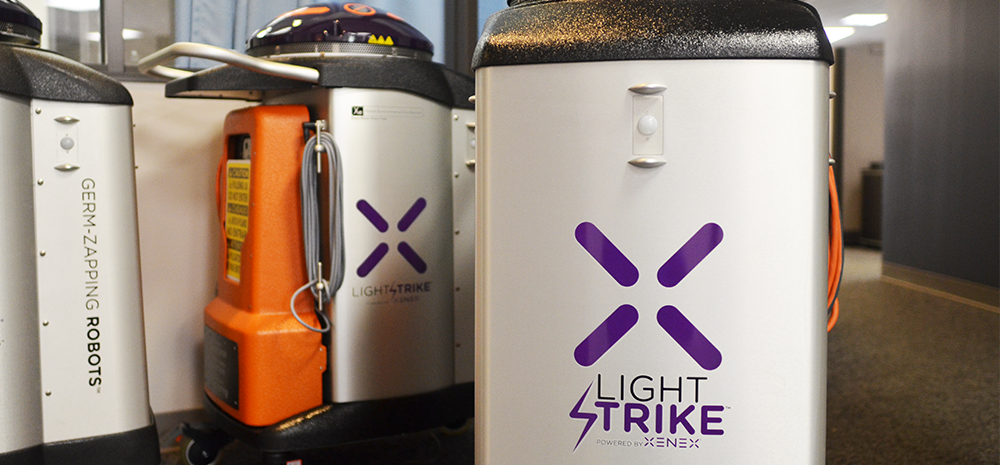Operating rooms are supposed to be sterile environments, but studies show that they remain contaminated with microscopic pathogens that can cause Surgical Site Infections (SSI) even after they have been cleaned. SSIs, which are some of the most commonly occurring infections, can be devastating to patients and cost the hospital tens of thousands of dollars in additional patient care.
Xenex Disinfection Services’ LightStrike pulsed xenon Full Spectrum ultraviolet (UV) disinfection technology has been proven to quickly destroy the germs and bacteria in Operating Rooms (OR) that cause SSIs. Hundreds of hospitals use LightStrike Germ-Zapping Robots during the terminal cleaning process in the OR after the day’s procedures are complete. Xenex recommends running the robot for two 8- or 10-minute positions (depending on robot model) during the terminal clean. Multiple positions greatly reduces the impact of shadows on UV disinfection efficacy.
Studies show, however, that bioburden increases in the OR during the day. A leading U.S. medical institution recently studied the effectiveness of the Xenex LightStrike robot in its ORs and found that the LightStrike robot can effectively disinfect high touch surfaces in an OR in 2 minutes. This short cycle time may make between-case cleaning in the OR a viable option and something hospitals should consider operationalizing within their protocol.

(Image credit: Xenex Disinfection Services)
“Running a quick cycle in between cases can be very effective at bringing down the vegetative bacteria bioburden in the OR,” said Dr. Sarah Simmons, Science Director, Xenex. “The LightStrike robot turns on instantly (no warm-up or cool down time) so it can be brought into the OR to quickly disinfect the area around the surgical table in between procedures.”
Hospitals using the Xenex LightStrike system as part of their infection prevention protocol have published numerous studies reporting dramatic reductions in hospital infection rates, even Clostridium difficile (C.diff), which is particularly hard to destroy. Two hospitals experienced significant reductions in their SSI rates after they began using LightStrike to disinfect their ORs and published their results in peer-reviewed journals, crediting the Xenex disinfection robot for the role it played in those reductions.
“Hospitals considering UV disinfection technology need to carefully evaluate the clinical evidence that the technology is effective in the hospital setting – which means peer-reviewed studies that show how a hospital has experienced a decrease in infection rates after using a UV disinfection system,“ said Dr. Mark Stibich, Chief Scientific Officer and co-founder of Xenex. “Numerous facilities have reported dramatic reductions in their infection rates, including SSI rates, after using our pulsed xenon UV disinfection system to destroy pathogens in their facilities. Our robots work quickly and efficiently, which enables hospital EVS to run them consistently – and enhance patient safety by destroying the microorganisms that could cause infections.“
The Xenex system is the only UV light disinfection technology shown, in multiple peer-reviewed published studies, to help hospitals reduce infection rates. Xenex Germ-Zapping Robots have been credited for helping healthcare facilities in the U.S. decrease their Methicillin-resistant Staphylococcus aureus (MRSA), C.diff and Surgical Site infection rates by more than 50, 70 and 100 percent respectively.
Uniquely designed for ease of use and portability, a hospital’s environmental services staff can operate the Xenex robot without disrupting hospital operations and damaging materials or equipment in the OR. With a four- or five-minute disinfection cycle, the robot can disinfect 30-62 hospital rooms per day (according to Xenex customer reports), including patient rooms, ORs, equipment rooms, emergency rooms, intensive care units and public areas. More than 400 hospitals, Veterans Affairs and Department of Defense facilities in the U.S. are using Xenex robots, which are also in use in skilled nursing facilities, ambulatory surgery centers and long term acute care facilities.




